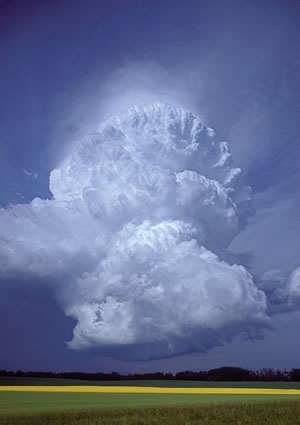Big Weather
Hold on to your hats! The weather, she-is-a-changing. Global warming is exacerbating Canada’s gloriously variable weather, adding a growing current of concern to our favourite topic of conversation. It’s been more than two decades since the “big tornado” hit these hills in 1985, but in recent years the incidence of smaller tornadoes, high winds and violent storms has escalated.
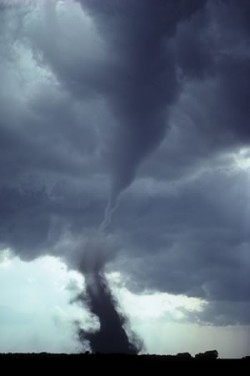
It’s been more than two decades since the “big tornado” hit these hills in 1985, but in recent years the incidence of smaller tornadoes, high winds and violent storms has escalated. Photo by Arjen and Jerrine Verkaik.
On December 28, 2008, I lounged in bed, keenly aware of the empty silence that comes on the heels of Christmas celebrations. A howling wind pulled me from my reverie. Through the window, I could see the trees whirling like giant tops. Then there was a thump. A sixty-foot poplar had broken at the base, karate chopping into the corner of our roof. My husband and I ventured outside to assess the damage, but the roar of the wind made speaking impossible. Trees cracked on the escarpment ridge and we knew it was no time to be climbing a ladder for a look-see.
Although the house sustained minor structural damage, the interior was mercifully unscathed. The tree was removed and the house tarped off until spring weather permitted repairs. For us, it was the worst in what seemed like an escalating series of 100-kilometre windstorms.
That winter day was windy, for sure, but we’ve seen windier ones. Take May 31, 1985, for example, when a deep low-pressure area from the midwestern United States collided with a strong cold front, turning loose a slew of as many as eleven tornadoes throughout Southern Ontario and whirling a whopping twenty-six through Pennsylvania, Ohio and New York.
Twelve people died in Ontario that day, and seventy-six in the U.S. Although it was difficult to define the exact path of each twister, the effects were felt in more than a dozen communities. A large swath was cut through the City of Barrie, and closer to home, Corbetton, Hopeville, Lisle, Terra Nova and Hillsburgh all experienced damage. One tornado travelled on ground for approximately 110 kilometres – the longest recorded track in Canadian history – touching down north of Arthur, sweeping through Grand Valley and Mono, then spinning on through Tottenham and rural York Region before dissipating near Mount Albert.
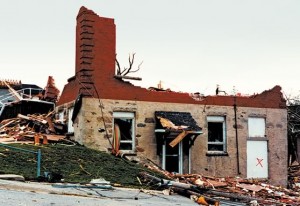
The 1985 tornado destroyed 66 buildings in Grand Valley, including the library shown here. The seven people in the library at the time survived. Photo by Les Canivet.
Les Canivet, Grand Valley’s first full-time village clerk, was working that afternoon in the municipal office beneath Grand Valley Public Library. “The sky was getting very dark and I knew something bad was going to happen,” Les, now 88, recalls.
He ran toward the staircase to shout up to librarian Shann Leighton to get downstairs, but by the time he had travelled the eight strides to the stairwell he found it blocked by bricks from the walls. The sound of the wind was overpowering and Les returned to the safety of his office. “After a few minutes I looked outside and all I could see was water and wires.”
In those few minutes, an F4 tornado had shot down Grand Valley’s Amaranth Street with a circular wind speed of approximately 400 kilometres per hour and a ground speed of 100 kilometres per hour. Two people, Barry Wood and Matilda McIntyre were dead and more than a hundred required medical treatment.
“It took a long time to get it through my thick skull that this had been a life-threatening moment,” Les says. A piece of sheet metal had torn through a boarded-up window, shearing across Les’s desk at what would have been his throat level. “I could have been decapitated.”
Les’s first thought was for the safety of his baby granddaughter who was with a sitter nearby. He got his bearings and left the office, carefully closing and locking the solid glass door. An OPP officer (one of fifty dispatched to Grand Valley during the emergency) was outside and asked why Les was locking the door. “I told him it was a business office and it had to be locked,” Les says. The officer pointed out that the glass was shattered and anyone could walk right through the door. “After that, every time an OPP officer saw me he’d say ‘lock the door’.”
After determining his granddaughter was safe, Les returned to assist those trapped in the library rubble. Only the southwest corner remained of the sturdy brick building constructed in 1913 with a grant from the Andrew Carnegie Corporation.
Despite the devastating wreckage, librarian Shann Leighton, Alan and Joan Cromack, Wilfred McLean, and children Kathryn and Ricky Moore survived. Their injuries ranged from mere scrapes and bruises to a broken leg, cracked vertebrae and a punctured lung. Seven-year-old Kathryn was buried under crumbled library walls for over an hour before being pulled to safety, unhurt except for some scrapes and a black eye.
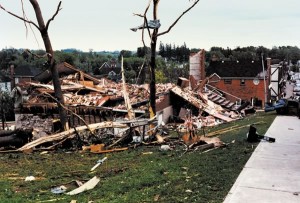
The 1985 tornado destroyed 66 buildings in Grand Valley, including the library shown here. The seven people in the library at the time survived. Photo by Les Canivet.
Volunteers salvaged approximately 500 of the library’s 7,000 books and, with the help of libraries in Elora, Acton and Georgetown, library service returned three weeks later in a “bookmobile” loaned by the Kitchener library. Files in the municipal offices were undamaged and a new public library and municipal office opened in June 1988.
Minutes after the tornado whirled down Amaranth Street destroying buildings, damaging five churches and the medical-dental centre, and leaving as much as $10 million in damages, Wayne and Barb Molto’s ten-acre property on the Mono-Amaranth town line also became fodder for the tornado.
Barb had finished work at 3:30 p.m. that day and was in Orangeville picking up her eleven-year-old son, Greg, from his friend’s house. “There were huge hailstones about two inches in diameter and the sky was black,” Barb recalls. She waited out the short storm and, when the weather cleared, bought groceries and headed home with her son.
Concerned by the escalating tree damage along the road, Barb was shocked to see the roof of neighbours Bernadine and Casey Kooman’s house was gone.
“We drove a little further and I saw my house – the roof and walls were gone and the dining-room wall had completely collapsed,” Barb remembers. “It was like a doll’s house where you could look right into all the rooms.” In the kitchen, the roof and back wall had vanished but one cupboard remained, the cups hanging eerily undisturbed on their cup hooks.
Unknown to Barb, her eighteen-year-old daughter, Debbie, had returned home from work early that day and was in the house when the tornado struck. Debbie saw the dark green sky moving toward her. Hearing a wind that sounded like a freight train, she wondered if there had been a bomb, an explosion or an invasion. When the front door blew open, she grabbed the door, but it blew off, sucking her out of the house. She held onto the railing on the porch steps until the wind subsided, then ran to her neighbours’ house without looking back.
Loretta and Nick Antonacci told Barb that an unknown man had given Debbie a ride to the Orangeville hospital. With that news, Barb’s fear escalated. Antonaccis took her inside, steadying her nerves with a stiff drink chilled with one of the two-inch hailstones they had saved from the storm.
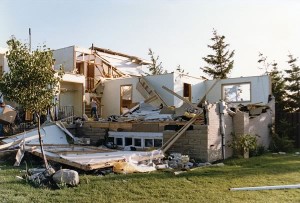
Debbie Molto, 18, was at home when the tornado struck on May 31, 1985. The house (above) was destroyed, but Debbie managed to escape unhurt. Photo by Debbie Molto.
“So I drank the hailstone drink and tried to phone the hospital, but of course the lines were all crossed and confused,” Barb says. Miraculously, on one attempt to call the hospital, she picked up the phone and heard a voice – it was Debbie, calling from a friend’s home in Orangeville. She was unhurt.
In the days and weeks following the tornadoes, groups of Amish and Mennonite men from Listowel aided in the clean-up, picking up debris and even assisting with a barn-raising in East Luther. Volunteers set up a food and clothing distribution centre in Grand Valley, serving an average of 300 people at each meal.
“There were about 1,000 residents in Grand Valley at the time,” Les Canivet says, “and, with sixty-six commercial and residential buildings completely destroyed, we lost a full third of our tax assessment.” Even so, Les recalls that not one person came into his office with a complaint about the clean-up and rescue operations.
Amish and Mennonites also assisted the Molto family in a clean-up that recovered some of their odds and ends, as well as some unknown homeowner’s toilet seat, dumped by the tornado in the far reaches of their property. For two weeks, the Moltos lived in two rooms in Orangeville’s Panorama Inn – one room for the family and one room for their few retrieved belongings.
“We rebuilt on the same spot,” Barb says. “The four of us lived in a sixty-foot mobile home on the property from May until November. I’ve said many times, that if you ever want to test your marriage…”
That wild May day in 1985 has left its mark. Each person, whether directly or indirectly affected, retains a sense of awe at nature’s clout and those few surreal minutes before the winds calmed and the sun returned. The rows of maple trees lining Grand Valley’s Amaranth Street will never rival their former glory, but homes, buildings and churches have been rebuilt, lives have returned to normal.
Since 1985, smaller twisters have given area residents their fair share of memories. In 1989, only months after moving to Erin, lawyer Ken Torrens and his guests watched a tornado bounce towards his Main Street house. The tornado, which likely blew in from Belwood where more serious damage was sustained that day, brought the typical deep green sky and skipped over his house, shearing off maple trees across the street.
In July, 1993 a mini-tornado added a memorable twist to the wedding celebration of the daughter of Cecile and Ken Weber of Caledon East. As guests gathered for dinner under a tent, the wind suddenly roared, seeming to suck the tent poles from the ground. The Webers and their guests grabbed the poles and hung on for dear life. The tent held, but the violent couple of minutes left the door of the tent blocked by a downed tree. A few stalwart men climbed out, found a chainsaw and freed the guests. Worse, a power failure had inexplicably locked the oven door, imprisoning the reception meal inside. That problem was solved by the inventive caterers who whipped back to Bolton and cooked up pasta on a gas stove.
“For a long while after the tornado, material things meant nothing to me and I now have a different perspective on life,” Barb Molto says. “I realized that it doesn’t matter what you have, everything can be taken away from you except your belief in God or your faith in yourself. Even your family can be taken away – the only thing you have is what is in you, and the only way anything can touch that is if you allow it.”
Winds of history
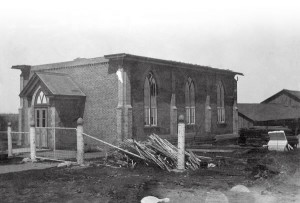 In what was dubbed “The Great Storm” of 1887, the massive spire on St. Mark’s Episcopalian Church in Orangeville blew down, never to be replaced.
In what was dubbed “The Great Storm” of 1887, the massive spire on St. Mark’s Episcopalian Church in Orangeville blew down, never to be replaced.
—
On April 14, 1909 a windstorm swept over the Orangeville area causing damage to barns, windmills and a few churches, including Mono’s Ebenezer Church in Relessey (shown below) which lost its roof and spire.
—
In October 1954, Hurricane Hazel’s impact caused flood damage in a newly constructed south wing of Orangeville’s Lord Dufferin Hospital. The water rose two metres in the basement, ruining chemicals, bandages, blankets and other equipment. Grand Valley residents were marooned when cut off from the town by the Grand River, which rose 25 centimetres in 20 minutes, flooding the area. The Holland Marsh was flooded when up to six metres of water backed up from Lake Simcoe into the marsh. A reported six to eight billion gallons of water were pumped from Holland Marsh’s 2,000-hectare eastern section over 24 days.
—
On August 30, 1970, a massive 18,000-metre thunderhead built up steam over Toronto, gathered momentum and headed toward Orangeville, unleashing heavy rain and winds up to 129 km/hr over Caledon Village. The electrical storm tore off roofs, felled trees and power lines. On the corner of highways 10 and 24, the roof of Mary L. Adams Antique Shop was lifted off its foundations and tossed into the next yard. Homes and farms in Alton and the Orangeville area also sustained damage, uprooted trees and electrical disruptions.
—
Weird weather
According to the Integrated Regional Information Networks (part of the UN Office for the Co-ordination of Humanitarian Affairs) “the factors most often blamed for the increase in natural disasters are environmental degradation, climate change, population growth (in particular, unplanned urban growth), and the negative results of economic globalization.”
The International Federation of the Red Cross and Red Crescent Societies, which publishes a World Disasters Report annually, reports that “from 1994 to 1998, reported disasters averaged 428 per year. From 1999 to 2003, this figure shot up by two-thirds to an average of 707 natural disasters each year.”
—
In the summer of 2006, 23 tornadoes struck Ontario during three separate storms. On August 2, the season’s second major storm triggered 14 tornadoes, including two F2 touchdowns – the highest number of tornadoes for a single event in the province and the number normally recorded for the entire year.
—
Above-normal winter temperatures throughout Canada produced three times the average number of tornadoes in March 2007.
—
The strongest twister in Canadian history struck the community of Elie, Manitoba on June 22, 2007. Packing winds of over 420 km/h, it qualified as Canada’s first F-5 tornado on the international Fujita Scale.
—
Unprecedented damage from windstorms throughout the spring and summer of 2007 left Toronto residents waiting for up to 18 months for tree services. The department logged more than 7,700 storm-related service requests (compared to a total of 1,355 in 2004 and 5,764 in 2006).
—
Gales reaching as high as 100 km/h swept unseasonably warm weather into southern Ontario on January 9, 2008, creating fog and dumping 30 to 35 ml of rain. The sudden snow melt caused widespread flooding of the Grand River watershed. Temperatures hit record highs of up to 15°C. Several rare winter tornadoes touched down along the Illinois-Wisconsin border.
—
Howling winds gusting up to 93 km/hr downed power lines and brought schools and businesses to a standstill when all municipal roads and highways in Dufferin were closed on Wednesday, January 30, 2008. The next day temperatures plummetted and brought 10 to 20 cm of snow on Friday.
—
A storm trough of deadly tornadoes rampaged through five states on February 6, 2008, killing at least 54 people, making it the deadliest barrage of twisters since May 31, 1985. The system brought driving snow and strong winds to the GTA, also creating thundersnow, a rare occurrence caused by winds that separate snow crystals vertically by weight. Fine crystals higher in the air are positively charged, while heavier flakes at the bottom are negatively charged. Lightening jumps across the resulting charge gap.
—
December 28, 2008, gale force winds pummelled southern Ontario with gusts up to 100 km/h. Trees were uprooted, hydro lines downed and trailers flipped onto their sides. As many as 230,000 hydro customers were without power in parts of rural Ontario. Flooding of the Nith River in New Hamburg (west of Kitchener) saw waters flowing at 425 cubic metres per second. The average summer flow is two cubic metres per second.
—
April 25, 2009, Pearson International Airport clocked winds with gusts up to 115 km/hr, the fastest recorded in more than 30 years.
—
More Info
Photographers and authors Arjen and Jerrine Verkaik are “sky chasers.” Based near Elmwood in Grey County, they travel across North America documenting tornadoes and other weather phenomena. See their work at www.skyartstock.com.
Related Stories
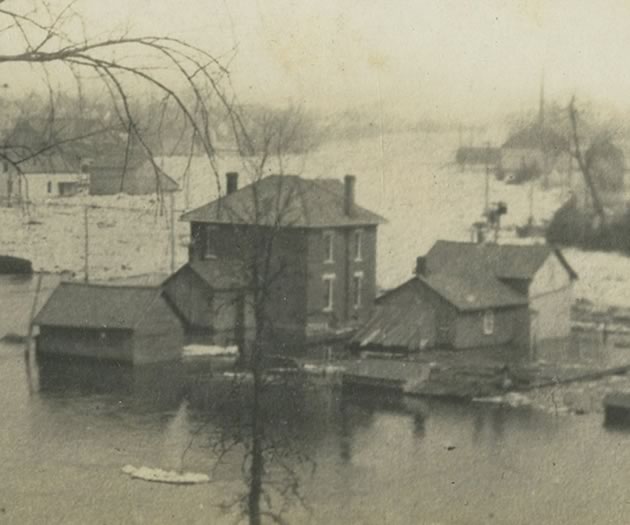
The Grand River – When Your Neighbour is a River
Jun 20, 2016 | | Historic HillsNot only does the Grand River lay out nature’s beauty, it also offers opportunities for recreation, commerce and development. Yet all this comes at a cost, for the Grand can be both friend and foe.





